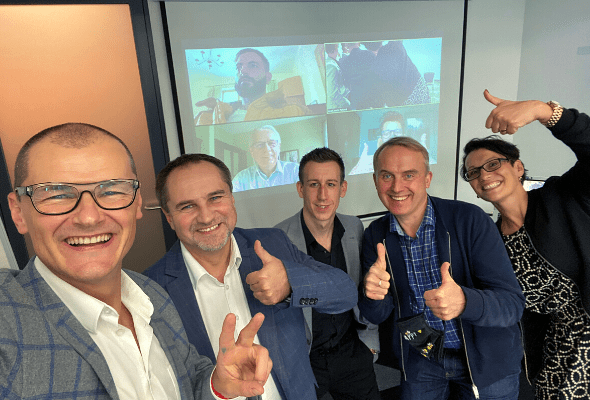OKR method – what is it and how is it used? Goals and key results: 5 rules for effective planning and achieving goals in teams and organizations

„The OKR model helped us achieve tenfold growth and then repeat this feat many times over.” – Larry Page, founder of Google (page 13 „How Google, Bono and Gates Are Rocking the World with the OKR Method” – John Doer)
As an entrepreneur, you probably know various classic company management and objective management systems, including the MBO method, i.e. Management by Objectives. In today’s article, we will present the OKR goal management method, which is currently the most effective method of managing organizational goals, used by business owners and managers managing teams and projects. It is often used by Turquoise Organizations, startups, software houses, IT companies and rapidly developing and scaling companies. In this article you will find the OKR examples too.
OKR method – what is it?
The name of the method comes from English. OKR stands for Objective Key Results, and to put it even more precisely:
O – Objective – Achievement, Goal, Success (usually one ambitious goal for the year and the next quarter)
KR – Key Results – 2-4 measurable results, milestones that will measure whether you have achieved the Achievement/Goal
The OKR method is aimed primarily at organizations, but it can also be used to measure effects in individual projects, so it can also be used by managers, not only company owners. This method was developed at Intel, and today it is used by companies such as Google and Allegro.
OKRs include not only the main, clearly defined and ambitious goals, but also the process of setting priorities and practices that are supposed to bring us closer to this goal.
For OKRs to be effective, 5 key principles for their effective planning and implementation must be implemented.
1. A defined clear, understandable and ambitious goal to be achieved
The established objective should be short, understandable, engaging, ambitious and clearly defined. It is not only a goal in itself, but also a mission, a slogan that makes us want to pursue this goal. An example is „We are the most recognizable business coaching company in Poland.” When creating an Achievement, think about a strategic slogan/phrase (qualitative achievement) that you can implement or you can implement with your team and thanks to which you will take yourself, your organization or the area for which you are responsible to a higher level of development. When implementing OKRs for a large organization with several hundred people, make sure that the teams create their own, ambitious goals that are consistent with the main goal of the organization.
Here are some examples of OKRs:

2. Measurable and specifically defined 2-4 key results that can be easily assessed and answer the question: „have we achieved or not achieved”
Key Results are a set of metrics that bring us closer to our goals and allow us to continuously determine their progress. When creating Key Results, think about the specific results that will let you know that you and others have achieved your intended goal. For one Achievement, create a maximum of 4 key results or 4 milestones that you can measure. Using the OKR method, each individual or team should create their own key results.
3. Transparency of goals throughout the organization and a transparent system with access and progress updates
The OKR method supports transparency, or in other words – transparency of goals. They should be clear and understandable to every person in the organization. Thanks to this, each team member knows how their daily work affects the entire company. Everyone has ongoing access to checking the progress of goals, which allows for possible changes that will bring us closer to the effect and allow us to work even more effectively. Ongoing team discussions on Key Results provide insight into how each person’s daily work impacts the final results.
4. Quarterly planning and appreciation of achievements, learning for the future with unrealized OKRs
For the OKR method to be effective, you should determine what you want to achieve in the next quarter. Operating in such a system is much more effective than setting goals for, for example, the next month. Monitoring a given goal can take place once a week during a meeting with the leader or once a month during a discussion by the entire team. After the end of the quarter, you should make a summary and assess whether the assumed goal was achieved, and if not – what can be changed in the future to get closer to it. This is important to draw conclusions and next time avoid mistakes that occurred along the way.
5. Acceptance and appreciation when an ambitious OKR is 70% or 80% achieved, openness to continuous learning.
It is important that after establishing OKRs, you have support from the entire team and mutually appreciate each other’s effects and are open to continuous learning and drawing conclusions. Setting a very ambitious OKR and achieving, for example, an 80% effect will still be a very good result. Of course, as always, you need to analyze what was done well and what can be improved. If, by implementing the OKR system, teams begin to regularly achieve 100% of their goals and key results, it may mean that they are afraid to set ambitious goals and achieve them, which means that OKR has not been properly implemented in the organization.

OKR Examples
Below you will find two OKR Examples:
Annual OKR for the organization: 2020: „Grow your company globally”
KR-1: Achieve global sales of….
KR-2: Increase sales by 100% in the CEE region
KR-3: Increase your global sales team by 100%
OKR for Q1 for the team/department/circle: 2020-Q1: „Successfully launch the new XYZ service in Q1”
KR-1: Win the „Best Launch and New Service in the XYZ Industry” Award at the XYZ Conference
KR-2: Sell the new XYZ service to 20 new customers
KR-3: Obtain 10 written recommendations from customers who have used the service and recommended it to their friends
More about topics of OKR you can find also on the article on our partners blog Holaspirit.
Considering how many world leaders use the OKR method, we have no doubt that it is the most effective method of achieving goals and developing the company nowadays. Our #PerfectCircle team implemented the OKR method a year ago using the holaspirit platform. The OKR method helps us develop the company quickly and maintain complete transparency and agility in managing the organization’s goals. We are also a Polish partner of the holaspirit.com platform, which is equipped with the function of entering, monitoring and updating OKRs. We also help other companies successfully implement the OKR method throughout the organization. Additionally, thanks to the holaspirit platform, you can implement self-management, holacracy, sociocracy and create a Turquoise Organization.
Regularly, every last Tuesday of the month at 10:00 we organize a free #TurquoiseWebinar, during which Marek Wzorek and/or Artur Szmiłyk share knowledge and best practices in creating turquoise organizations and transforming organizations. We also invite you HERE for a free consulting session to discuss your challenges related to the development of yourself, your teams and your organization.

